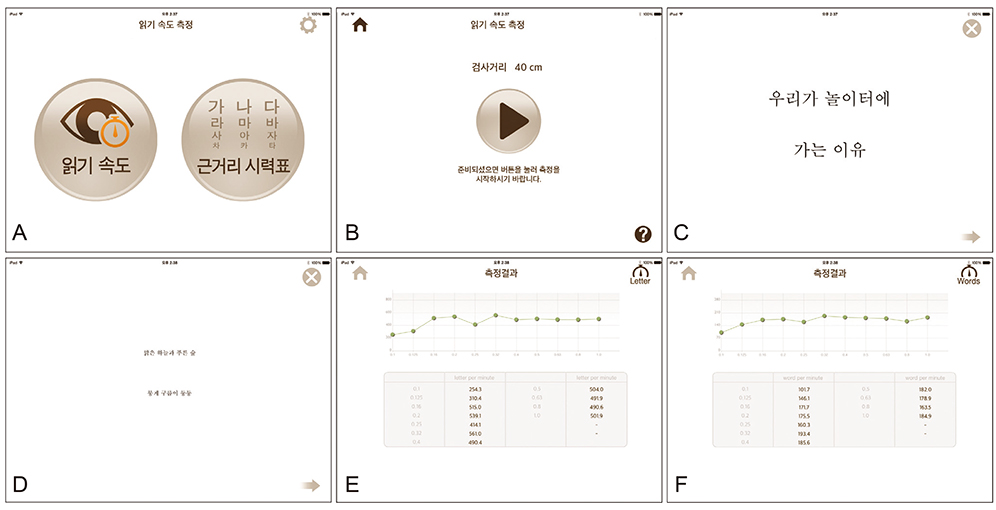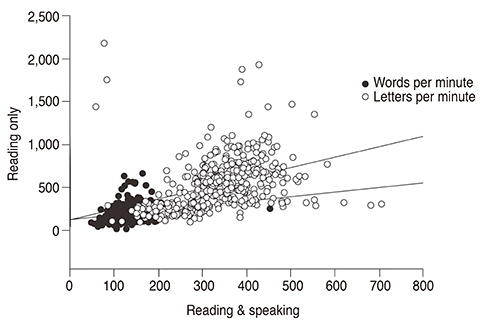Korean J Ophthalmol.
2017 Jun;31(3):202-208. 10.3341/kjo.2016.0042.
Korean Version Self-testing Application for Reading Speed
- Affiliations
-
- 1Department of Ophthalmology, Hallym University Dongtan Sacred Heart Hospital, Hallym University College of Medicine, Hwaseong, Korea.
- 2Republic of Korea Air Force 17th Fighter Wing, Cheongju, Korea.
- 3Department of Ophthalmology, Chungbuk National University College of Medicine, Cheongju, Korea. phaco@mailo.cbnuh.or.kr
- 4Department of Ophthalmology, Jeju National University School of Medicine, Jeju, Korea.
- 5HanGil Eye Hospital, Incheon, Korea. limthnet@naver.com
- KMID: 2379876
- DOI: http://doi.org/10.3341/kjo.2016.0042
Abstract
- PURPOSE
This study introduces a reading chart application for the iPad tablet in the Korean language and investigates the reading speed in a normal-sighted population according to age group.
METHODS
Sixty-three Korean sentences were selected from textbooks for second grade elementary school students. A commonly used typeface in everyday printed material, "BatangChe," was used. Letter size was presented in logarithm of the minimum angle of resolution (logMAR) 0.0 to 1.0 at 0.1 logMAR steps at a reading distance of 40 cm. A third generation retina display iPad was used to present the chart, and the sentences were presented randomly for each size of letter. The subjects repeated the test silently (reading only) and out loud (reading and speaking) to prevent them from skipping reading words. Pilot testing followed in 65 normal vision adults under 60 years of age.
RESULTS
The mean reading only speed for logMAR 0.5 optotype (point 10) was 121.1 ± 47.2 words per minute (wpm) for people in their 20s (n=21), 116.5 ± 38.3 in their 30s (n=27), 93.8 ± 12.6 in their 40s (n=9), and 56.5 ± 42.7 (n=8) in their 50s. There was a significant correlation between age and reading and speaking speed (r=−0.48, p<0.001). The mean reading only speed for logMAR 0.5 optotype (point 10) was 202.3 ± 88.4 wpm and the mean reading and speaking speed was 129.7 ± 25.9 wpm, with significantly different (p<0.001).
CONCLUSIONS
This Korean reading chart application could present a new standard when checking reading speed according to age groups.
Keyword
Figure
Reference
-
1. Chia EM, Wang JJ, Rochtchina E, et al. Impact of bilateral visual impairment on health-related quality of life: the Blue Mountains Eye Study. Invest Ophthalmol Vis Sci. 2004; 45:71–76.2. Mataftsi A, Bourtoulamaiou A, Haidich AB, et al. Development and validation of the Greek version of the MNREAD acuity chart. Clin Exp Optom. 2013; 96:25–31.3. Friedman SM, Munoz B, Rubin GS, et al. Characteristics of discrepancies between self-reported visual function and measured reading speed: Salisbury Eye Evaluation Project Team. Invest Ophthalmol Vis Sci. 1999; 40:858–864.4. Rubin GS, West SK, Munoz B, et al. A comprehensive assessment of visual impairment in a population of older Americans: the SEE Study. Salisbury Eye Evaluation Project. Invest Ophthalmol Vis Sci. 1997; 38:557–568.5. West SK, Munoz B, Rubin GS, et al. Function and visual impairment in a population-based study of older adults: the SEE Project. Salisbury Eye Evaluation. Invest Ophthalmol Vis Sci. 1997; 38:72–82.6. Radner W, Diendorfer G. English sentence optotypes for measuring reading acuity and speed: the English version of the radner reading charts. Graefes Arch Clin Exp Ophthalmol. 2014; 252:1297–1303.7. Legge GE, Ross JA, Isenberg LM, LaMay JM. Psychophysics of reading: clinical predictors of low-vision reading speed. Invest Ophthalmol Vis Sci. 1992; 33:677–687.8. Legge GE, Ross JA, Luebker A, LaMay JM. Psychophysics of reading: VIII. the Minnesota Low-Vision Reading Test. Optom Vis Sci. 1989; 66:843–853.9. Bailey IL, Lovie JE. The design and use of a new near-vision chart. Am J Optom Physiol Opt. 1980; 57:378–387.10. Radner W, Obermayer W, Richter-Mueksch S, et al. The validity and reliability of short German sentences for measuring reading speed. Graefes Arch Clin Exp Ophthalmol. 2002; 240:461–467.11. Radner W, Willinger U, Obermayer W, et al. A new reading chart for simultaneous determination of reading vision and reading speed. Klin Monbl Augenheilkd. 1998; 213:174–181.12. Yoon K, Brew C. A linguistically motivated approach to grapheme-to-phoneme conversion for Korean. Comput Speech Lang. 2006; 20:357–381.13. Cho JR, Chen HC. Semantic and phonological processing in reading Korean Hangul and Hanja words. J Psycholinguist Res. 2005; 34:401–414.14. Cho JR, McBride-Chang C, Park SG. Phonological awareness and morphological awareness: differential associations to regular and irregular word recognition in early Korean Hangul readers. Read Writ. 2008; 21:255–274.15. Wang M, Ko IY, Choi J. The importance of morphological awareness in Korean-English biliteracy acquisition. Contemp Educ Psychol. 2009; 34:132–142.16. Kniestedt C, Stamper RL. Visual acuity and its measurement. Ophthalmol Clin North Am. 2003; 16:155–170.17. Kim JH, Lee JW, Chung JL, et al. Combined implantation of monofocal and multifocal intraocular lenses in senile cataract surgery. J Korean Ophthalmol Soc. 2009; 50:1632–1638.18. Lee KB, Lee HJ, Jun SW, et al. A study of correlation among visual-verbal skills, binocular vision and school achievement. Korean J Vis Sci. 2008; 10:197–216.19. Lee SJ, Park JH, Lee SH, et al. The study on improvement of reading ability for Dyslexia wearing color filter lens (ChromaGenTM lens). J Korean Ophthalmic Opt Soc. 2011; 16:65–74.20. Park SH, Kim SH, Cho YA, Joo CK. The effect of colored filters in patients with Meares-Irlen syndrome. J Korean Ophthalmol Soc. 2012; 53:452–459.21. Sloan LL, Brown DJ. Reading cards for selection of optical aids for the partially sighted. Am J Ophthalmol. 1963; 55:1187–1199.22. Rubin GS. Visual acuity and contrast sensitivity. In : Ryan SJ, editor. Retina. St. Louis: Mosby;2013. p. 300–306.
- Full Text Links
- Actions
-
Cited
- CITED
-
- Close
- Share
- Similar articles
-
- Validity of Korean Version Reading Speed Application and Measurement of Reading Speed: Pilot Study
- A Comparison of Reading Speeds of Intermittent Exotropia and Normal Children
- Comparison of Near-Distance Reading Speed Based on the Intraocular Lens Type Using a Korean Reading Speed Measurement Application
- Reading Speed after Anti-vascular Endothelial Growth Factor Therapy in Patients with Wet Age-related Macular Degeneration
- The Usefulness of Aspheric Doublet Lens




